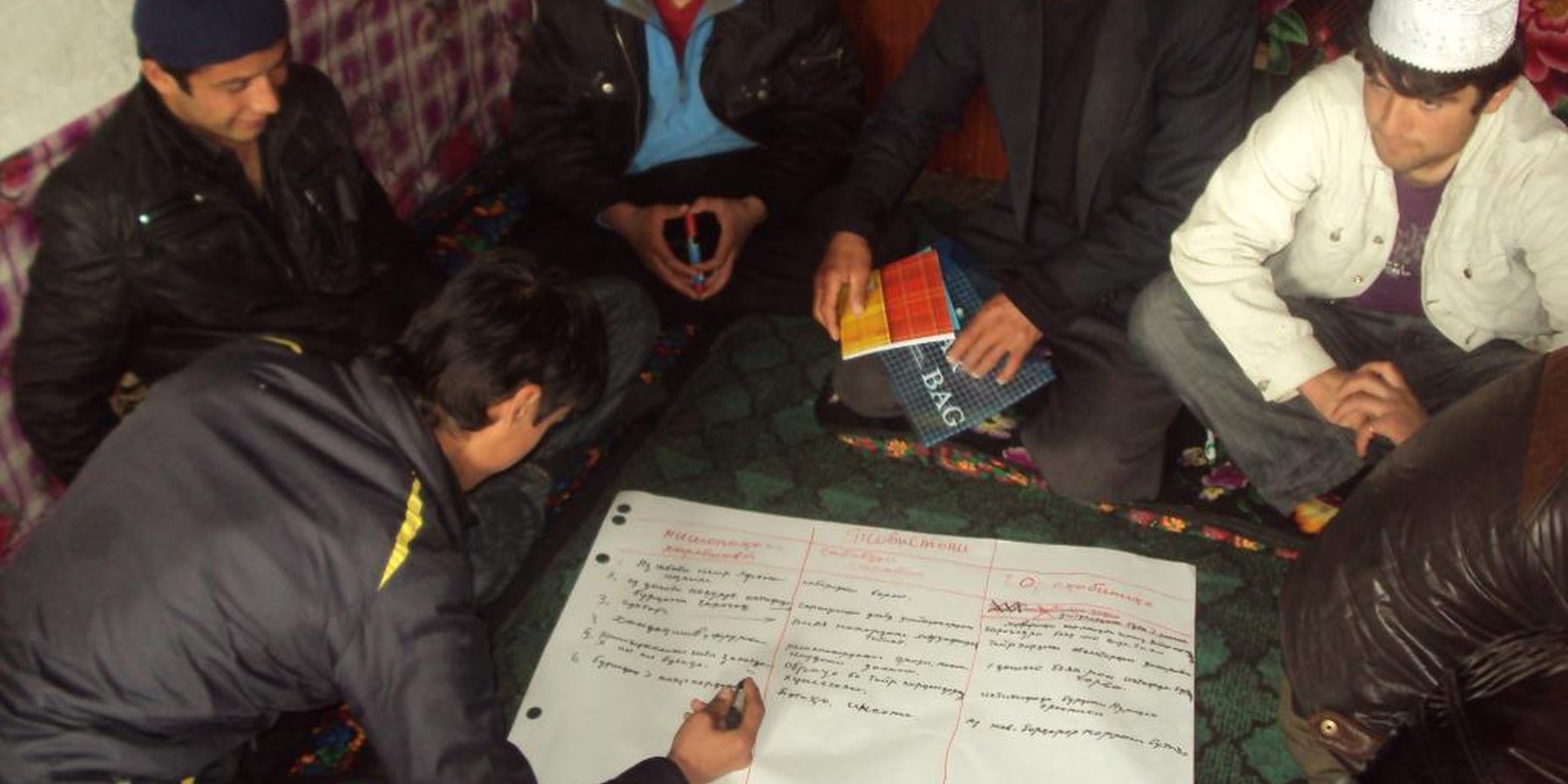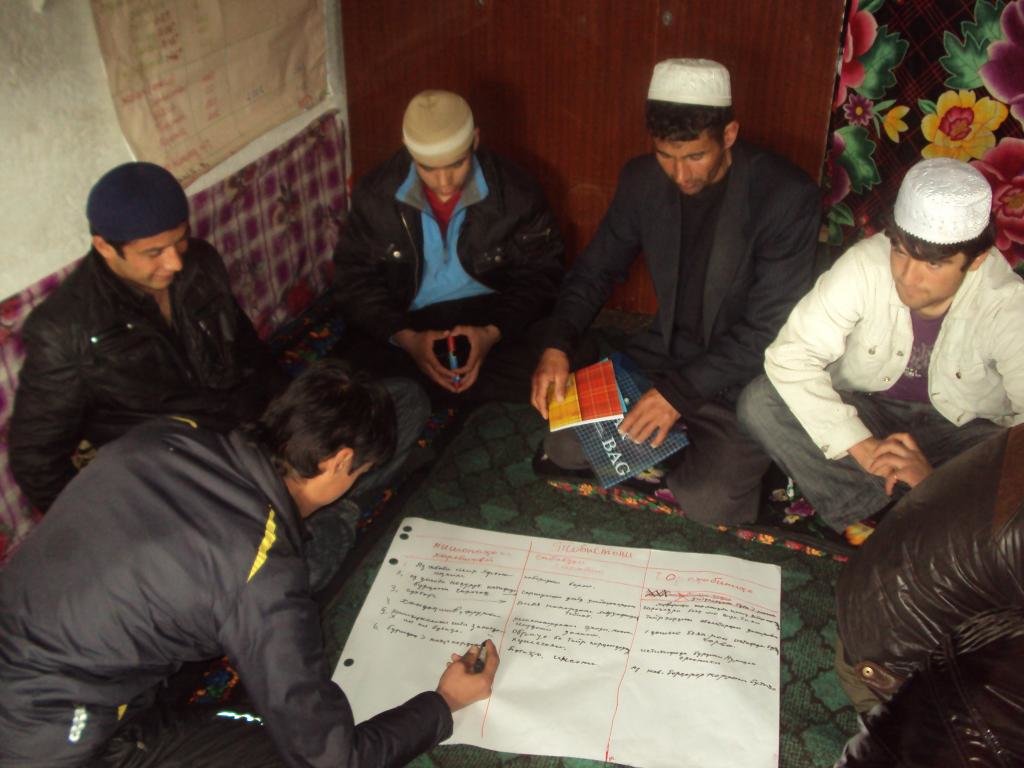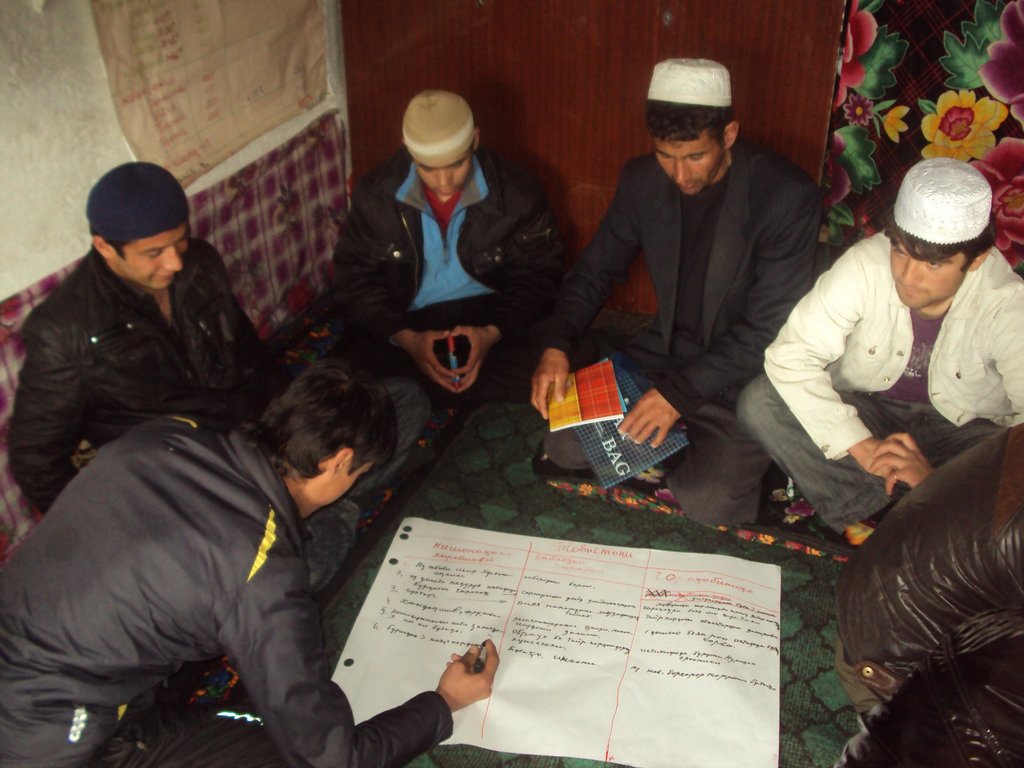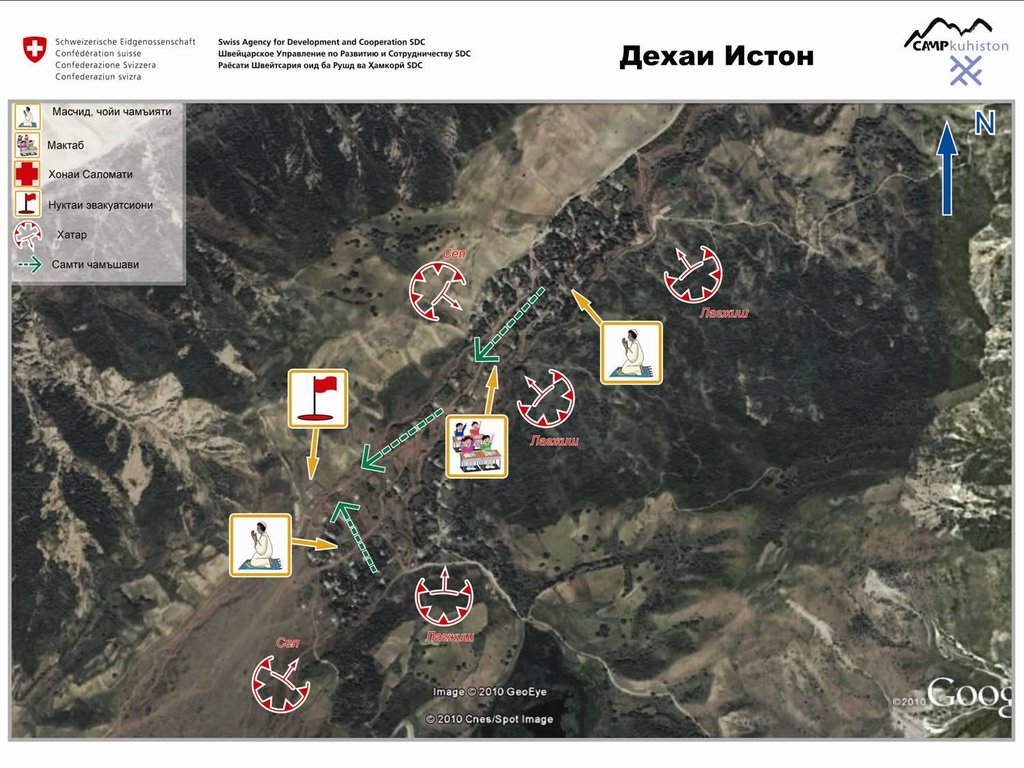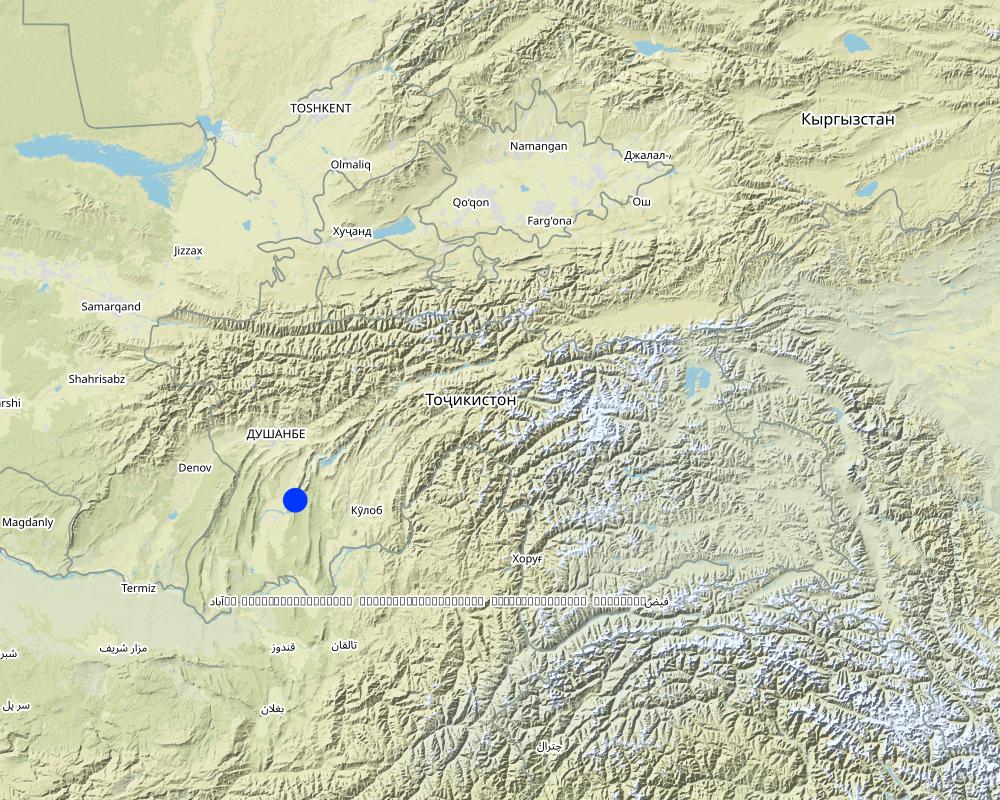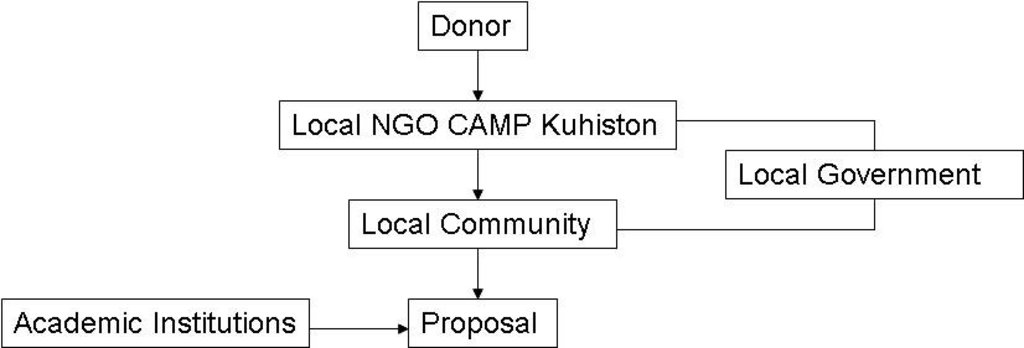Selection of SLM Technologies for Natural Disaster Risk Mitigation [Tajiquistão]
- Criação:
- Atualização:
- Compilador/a: shane stevenson
- Editor: –
- Revisores: David Streiff, Alexandra Gavilano, Joana Eichenberger
CAMP Kuhiston
approaches_2437 - Tajiquistão
Veja as seções
Expandir tudo Recolher tudo1. Informação geral
1.2 Detalhes do contato das pessoas capacitadas e instituições envolvidas na avaliação e documentação da abordagem
Especialista em GST:
Especialista em GST:
Pocheov Mirzokubon
+992 44 601 55 05
CAMP Kuhiston
Rudaki avenue, Dushanbe
Tajiquistão
Nome do projeto que facilitou a documentação/avaliação da Abordagem (se relevante)
Pilot Program for Climate Resilience, Tajikistan (WB / PPCR)Nome da(s) instituição(ões) que facilitou(ram) a documentação/avaliação da Abordagem (se relevante)
CAMP - Central Asian Mountain Partnership (CAMP - Central Asian Mountain Partnership) - QuirguizistãoNome da(s) instituição(ões) que facilitou(ram) a documentação/avaliação da Abordagem (se relevante)
CDE Centre for Development and Environment (CDE Centre for Development and Environment) - Suíça1.3 Condições em relação ao uso da informação documentada através de WOCAT
Quando os dados foram compilados (no campo)?
10/06/2011
O compilador e a(s) pessoa(s) capacitada(s) aceitam as condições relativas ao uso de dados documentados através do WOCAT:
Sim
1.4 Referência ao(s) questionário(s) sobre tecnologias da GST
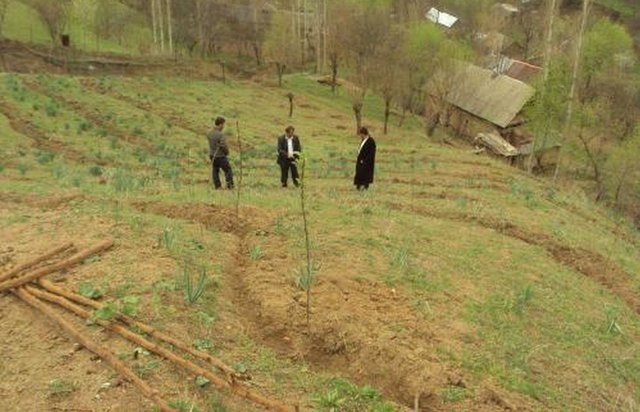
Planting of fruit trees to increase slope stabilisation [Tajiquistão]
Planting fruit tree orchards to increase the stability of the steep loess soil slopes.
- Compilador/a: Gulniso Nekushoeva
2. Descrição da abordagem de GST
2.1 Descrição curta da abordagem
Community Based Natural Disaster Risk Management Workshops for identification of locations for the implementation of SLM technology to reduce the risk to the village from natural disasters.
2.2 Descrição detalhada da abordagem
Descrição detalhada da abordagem:
Aims / objectives: The main objective was to use a community based participatory approach to evaluate the risk from natural hazards and aid in the effective selection of location and types of SLM Technologies that could be implemented. The workshop systematically works through the natural disaster risk assessment process which includes evaluation of the natural and human triggers that can causes and contribute to specific natural disasters and subsequently rank the risk as either high/medium/low based upon a predetermined criteria. The assessment is repeated with the assumption the SLM mitigation has been implemented to evaluate whether the natural disaster risk would be reduced.
Methods: Several methodologies are used in this approach, these include the, display of posters and photos, watching documentary style DVD’s, playing awareness raising training games, and distribution of brochures to educate the communities on the causes and impacts of natural disasters so that they can then complete a systematic risk assessment process. This is undertaken within the community using interactive participatory training modules and experienced teachers. Once the technologies are decided upon a proposal form is completed and copies submitted to funding agencies and the local government. A Memorandum of Understanding is signed with the local government to endorse the approach and any subsequent implementation activities. The proposal is vetted by experts for modification and approval to ensure best practice and sustainable results.
Stages of implementation: The communities are selected based upon natural disaster statistics and a natural disaster workshop conducted for up to twenty members of the community. At the completion of the workshop the community produce several proposals for the implementation of SLM technologies that will reduce the risk from specific natural disasters. The proposals are reviewed by experts from the soil institute and horticulture institute to ensure they are practical, viable and effective before final submission to the donor for funding. The local government remains informed of the activities throughout the process and is provided with copies of the proposals.
Role of stakeholders: NGO CAMP Kuhiston were the overall project managers. CAMP designed and conducted training on Disaster Risk Reduction and developed the natural hazard risk assessment process that leads to the formulation of the SLM mitigation proposals. CAMP are also responsible for engaging the experts and providing information to the local government who are asked to support the process. The community has to actively be involved and design their own proposal and decide how they will contribute to the implementation process.
Other important information: Although this could potentially be a lengthy process it is important that the communities understand why they have chosen a specific SLM technology and the desired impact that will help secure their livelihoods.
2.3 Fotos da abordagem
2.5 País/região/locais onde a abordagem foi aplicada
País:
Tajiquistão
Região/Estado/Província:
RRS
Especificação adicional de localização:
Nurabad
Comentários:
SLM was implemented in 7 different locations covering 5 villages within Mujiharf and Hakimi jamoats of Nurabad District. The two main watersheds are shown in the googleEarth file.
Map
×2.6 Datas de início e término da abordagem
Indique o ano de início:
2009
Ano de término (caso a abordagem não seja mais aplicada):
2011
2.7 Tipo de abordagem
- Baseado em projeto/programa
2.8 Principais metas/objetivos da abordagem
The Approach focused mainly on SLM with other activities (Natural Disaster Risk Mitigation)
The main objective was to educate the communities on the causes and triggers of natural disasters and how these triggers can be combated by SLM technologies. The approach concentrated on making the link between SLM technologies and causes of natural disasters. The risk assessment process helped communities understand how to evaluate the risk to their community from different types natural disasters and how these proposals would help reduce the risk presented by these types of natural disasters and also where is was the most effective and efficient use of time, finance and resources to reduce this risk.
The SLM Approach addressed the following problems: The stabilisation of degraded slopes that increased the risk to communities from natural disaster such as mud flows, landslides, and avalanches.
2.9 Condição que propiciam ou inibem a implementação de tecnologia/tecnologias aplicada(s) segundo a abordagem
Normas e valores sociais/culturais/religiosos
- Inibitivo
There were major problems incorporating women into the initial disaster risk management workshops and trainings. Therefore, there was limited input into the mitigation proposal development process.
Treatment through the SLM Approach: In some villages workshops were held separately from the men using female trainers. However, due to low educational backgrounds there was a limited the level of participation. The field training during the implementation stage managed to capture the women
Disponibilidade/acesso a recursos e serviços financeiros
- Inibitivo
There was initial concern that the farmers would not have finance to maintain the technology in the first year. The project was also conscious that fruit trees are subject to tax after three years.
Treatment through the SLM Approach: Farmers were provided with a minimal payment at different stages as the SLM technology developed.
Quadro institucional
- Inibitivo
The Jamoat wanted to have more say in the land owners who received the trees.
Treatment through the SLM Approach: The Jamoat were taken on site visits and were explained that the land was selected because of the hazard risk, not the land owner.
Quadro jurídico (posse de terra, direitos de uso da terra e da água)
- Inibitivo
There was no formal documentation to show who was the owner of the land.
Treatment through the SLM Approach: There was an informal agreement between the land user, village members and jamoat.
The existing land ownership, land use rights / water rights moderately hindered the approach implementation Although there are land use certificates available for farms, there are problems with allocating specific parcels of land to one particular land user. Therefore this issue needs to resolved before a technology can be implemented.
3. Participação e papel das partes interessadas envolvidas
3.1 Partes interessadas envolvidas na abordagem e seus papéis
- Usuários de terra/comunidades locais
Five local communities (20 people per community)
Individual land users were involved in workshops and planning of SLM Technology
Community were involved in workshops
Women particpitaed less, since there are noticeable gaps in the education levels of the genders and women fulfill a more traditional role centered around the household.
This area suffers from high levels of labour migration with many of the men working abroad in countries such as Russia. In particular separate workshops were held for women to ensure that they participated in the approach.
- Especialistas em GST/ consultor agrícola
Specialists were involved in selection of location of implementation
- Organização não governamental
CAMP Kuhiston
CAMP Kuhiston developed the approach in collaboration with international support, land users, academic institutions, the local community and local government.
- Governo local
Jamoats, Khukhmats
- Governo nacional (planejadores, responsáveis pelas decisões)
Tajik Soil Institute, Horticulture Institute,
- Organização internacional
Voluntary Services Overseas, University of Bern
Caso várias partes interessadas foram envolvidas, indique a agência líder:
CAMP Kuhiston
3.2 Envolvimento do usuários de terra/comunidades locais nas diferentes fases da abordagem
| Envolvimento do usuários de terra/comunidades locais | Especifique quem estava envolvido e descreva as atividades | |
|---|---|---|
| Iniciação/motivação | Nenhum | |
| Planejamento | Nenhum | |
| Implementação | Participativo | Involved in the workshops and the development of the proposals |
| Monitoramento/avaliação | Nenhum | |
| Research | Nenhum |
3.3 Fluxograma (se disponível)
Descrição:
Organisation chart showing how the proposal for the SLM technology developed.
Autor:
S. Stevenson (CAMP Kuhiston)
3.4 Decisão sobre a seleção de tecnologia/tecnologias de GST
Especifique quem decidiu sobre a seleção de tecnologia/tecnologias a serem implementadas:
- Principalmente especialistas em GST, após consulta com usuários da terra
Explique:
SLM specialists made the decision on the SLM technology, but consulted with the land users before implementation.
Decisions on the method of implementing the SLM Technology were made by NGO CAMP Kuhiston. NGO CAMP combined two funded projects to develop the approach for the implementation to the SLM technology with consultation from the Tajik Soil Institute and the Horticultural Institute.
4. Suporte técnico, reforço das capacidades e gestão do conhecimento
4.1 Reforço das capacidades/formação
Foi oferecida formação aos usuários da terra/outras partes interessadas?
Sim
Especifique quem foi capacitado:
- Usuários de terra
- 20 members of five communities received training.
Caso seja relevante, especifique gênero, idade, status, etnia, etc.
The training on the risk assessment process included all members of the community, although due to the conservative nature of the community some trainings were divided between women and men.
Tipo de formação:
- Em exercício
- Cursos
Assuntos abordados:
The initial training were on natural disasters, their casues and impacts. Subsequent training is the communites covered soil and water conservation and fruit cultivation.
4.2 Serviço de consultoria
Os usuários de terra têm acesso a um serviço de consultoria?
Não
4.3 Fortalecimento da instituição (desenvolvimento organizacional)
As instituições foram fortalecidas ou estabelecidas através da abordagem?
- Sim, pouco
Especifique a que nível (níveis) as instituições foram fortalecidas ou estabelecidas:
- Local
Especifique o tipo de apoio:
- Reforço das capacidades/formação
Dê mais detalhes:
Two academic institutions were financially supported to undertake the review and evaluation process. Local NGO camp was supported by international finance to implement the approach and subsequent activities.
4.4 Monitoramento e avaliação
Monitoramento e avaliação são partes da abordagem?
Sim
Comentários:
no. of land users involved aspects were ad hoc monitored by project staff through observations; indicators: The level of involvement in the workshops by the land users.
socio-cultural aspects were ad hoc monitored by project staff through observations; indicators: The level of engagement of the government and of the women in the process.
management of Approach aspects were ad hoc monitored by project staff through observations; indicators: International staff provided informal monitoring of the approach.
technical aspects were ad hoc monitored by other through observations; indicators: The academic institutions reviewed the proposals.
There were few changes in the Approach as a result of monitoring and evaluation: The risk assessment process was simplified and the format of the proposals was made more understandable to the participants.
There were few changes in the Technology as a result of monitoring and evaluation: The monitoring of the SLM technology means that for replication of the technology there would be changes in tree species selected.
4.5 Pesquisa
A pesquisa foi parte da abordagem?
Sim
5. Financiamento e apoio material externo
5.1 Orçamento anual para o componente de GST da abordagem
Caso o orçamento exato seja desconhecido, indique a faixa:
- 10.000-100.000
Comentários (p. ex. principais fontes de recursos/principais doadores):
Approach costs were met by the following donors: international non-government (International Consultants): 5.0%; international (Swiss Coorperation for Development and PAMS): 90.0%; local community / land user(s) (Local community support in kind): 5.0%
5.2 Apoio financeiro/material concedido aos usuários da terra
Os usuários da terra receberam apoio financeiro/material para a implementação de tecnologia/tecnologias?
Não
5.3 Subsídios para entradas específicas (incluindo mão-de-obra)
- Construção
| Especifique quais entradas foram subsidiadas | Em que medida | Especifique os subsídios |
|---|---|---|
| Parcialmente financiado | ||
| Parcialmente financiado | ||
- Outro
| Outros (especifique) | Em que medida | Especifique os subsídios |
|---|---|---|
| training materials | Totalmente financiado | posters, stationery and teachers salary |
Se a mão-de-obra pelos usuários da terra foi uma entrada substancial, isso foi:
- Voluntário
Comentários:
The approach was financed by funds from a donor.
5.4 Crédito
Foi concedido crédito segundo a abordagem para atividades de GST?
Não
5.5 Outros incentivos ou instrumentos
Foram utilizados outros incentivos ou instrumentos para promover a implementação das tecnologias de GST?
Sim
Caso afirmativo, especifique:
Two academic institutions were financially supported to undertake the review and evaluation process. Local NGO camp was supported by international finance to implement the approach and subsequent activities.
6. Análise de impactos e declarações finais
6.1 Impactos da abordagem
A abordagem auxiliou os usuários da terra a implementar e manter as tecnologias de GST?
- Não
- Sim, pouco
- Sim, moderadamente
- Sim, significativamente
The approach provided the land users with training, saplings and construction material to use the land in a more sustainable way.
A abordagem concedeu autonomia aos grupos social e economicamente desfavorecidos?
- Não
- Sim, pouco
- Sim, moderadamente
- Sim, significativamente
In some communities the women received specific training on the risk assessment process.
A abordagem melhorou as questões de posse de terra/diretos do usuário que inibiam a implementação das tecnologias de GST?
- Não
- Sim, pouco
- Sim, moderadamente
- Sim, significativamente
Where the technology was implemented, it made the community address the issue of land user rights. It is now apparent who is responsible for the SLM technology and for payment taxes on the land.
Did other land users / projects adopt the Approach?
- Não
- Sim, pouco
- Sim, moderadamente
- Sim, significativamente
Trainings were provided to other NGO's on the Natural Disaster Risk Assessment process and the development of proposals. The success of this has not been monitored.
Did the Approach lead to improved livelihoods / human well-being?
- Não
- Sim, pouco
- Sim, moderadamente
- Sim, significativamente
It improved their knowledge through training on Natural Disaster and on fruit cultivation and through the distribution of accompanying brochures.
Did the Approach help to alleviate poverty?
- Não
- Sim, pouco
- Sim, moderadamente
- Sim, significativamente
If the subsequently implemented technologies should help safeguard houses, land and livelihoods.
6.2 Principal motivação dos usuários da terra para implementar a GST
- Produção aumentada
fruit crops within 3-5 years
- Lucro (lucrabilidade) aumentado, melhora da relação custo-benefício
land previously had limited economic output.
- Prestígio, pressão social/coesão social
Government decree to plant trees
- Consciência ambiental
To decrease the communities exposure to natural disasters.
- well-being and livelihoods improvement
SLM technology should improve the livelihood of the land users.
6.3 Atividades de sustentabilidade de abordagem
Os usuários da terra podem manter o que foi implementado através da abordagem (sem apoio externo)?
- Não
Caso negativo ou incerto, especifique e comente:
The land users are not in a position to mobilise all the parties involved in the approach.
6.4 Pontos fortes/vantagens da abordagem
| Pontos fortes/vantagens/oportunidades na visão do usuário da terra |
|---|
| The process allowed me to make decisions concerning my own village. |
| The training improved my understanding of human and environmental causes of natural disasters. |
| Pontos fortes/vantagens/oportunidades na visão do compilador ou de outra pessoa capacitada |
|---|
| The approach involved a range of stakeholders and experts who were all able to actively contribute. (How to sustain/ enhance this strength: This could be enhanced by continued collaboration between all parties. ) |
| The approach included a community training element that benefited a broader range than just the land users. |
| The approach involved mobilisation of local government and community participation. (How to sustain/ enhance this strength: Further collaboration on technologies between the community and local government. The government to initiate replication in other communities. ) |
| The approach helped link the prevention of natural disaster with SLM practices. (How to sustain/ enhance this strength: The community developing further proposals for technologies and seeking funding to implement them.) |
6.5 Pontos fracos, desvantagens da tecnologia e formas de superá-los
| Pontos fracos/desvantagens/riscos na visão do usuário da terra | Como eles podem ser superados? |
|---|---|
| To provide more support on alternatives for SLM technologies. There must be new technologies that we are not aware of. | Further develop the modul to provide further illustrations of best practice. |
| Pontos fracos/vantagens/riscos na visão do compilador ou de outra pessoa capacitada | Como eles podem ser superados? |
|---|---|
| The approach covers only a one year period, therefore if the SLM technology has difficulties, such as disease which is highly prevalent in this area, the land owner may not be in a financial position to rectify the issue. | A longer monitoring and support period. |
7. Referências e links
7.1 Métodos/fontes de informação
- visitas de campo, pesquisas de campo
- entrevistas com usuários de terras
Links e módulos
Expandir tudo Recolher tudoLinks

Planting of fruit trees to increase slope stabilisation [Tajiquistão]
Planting fruit tree orchards to increase the stability of the steep loess soil slopes.
- Compilador/a: Gulniso Nekushoeva
Módulos
Não há módulos


